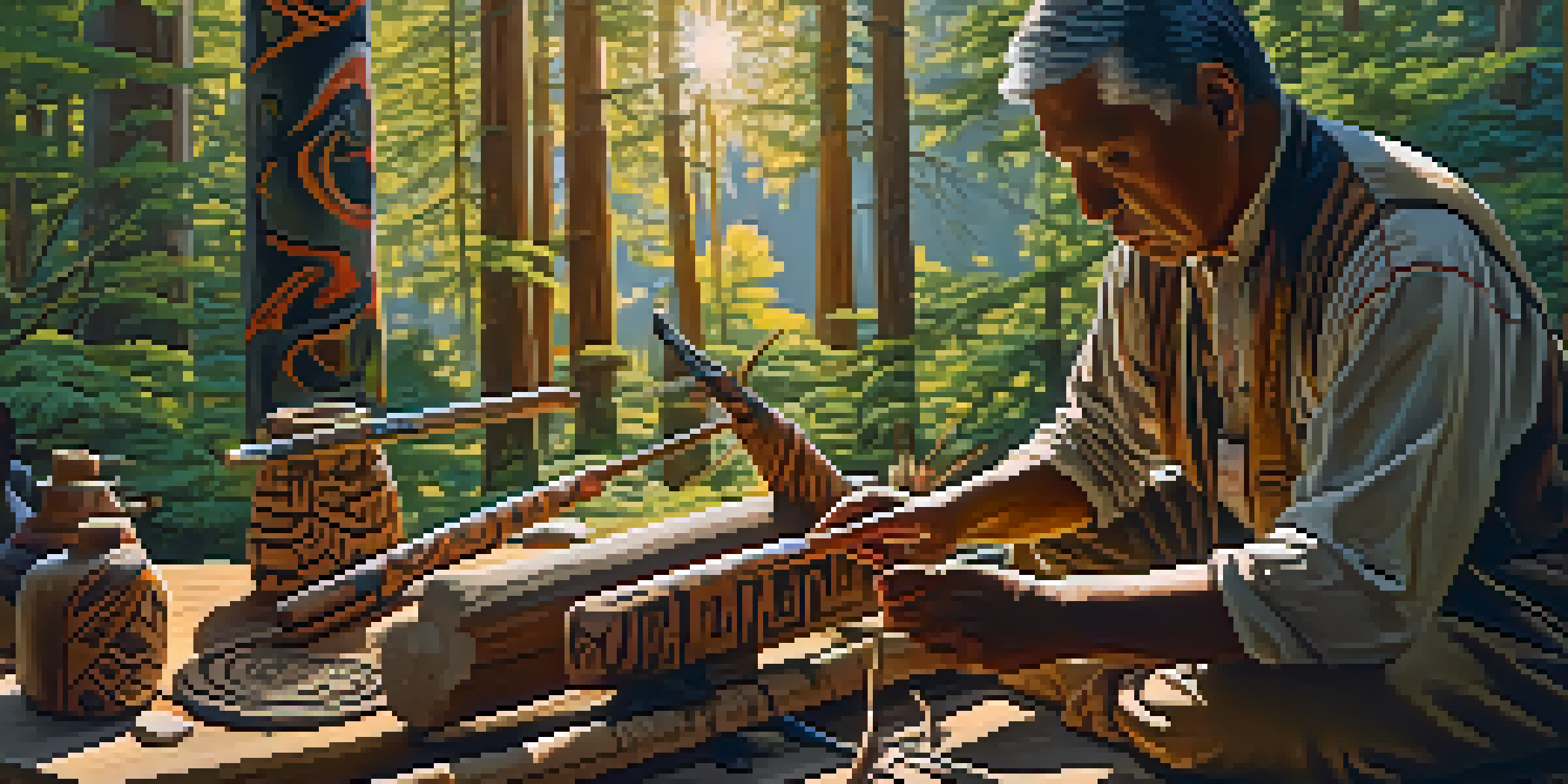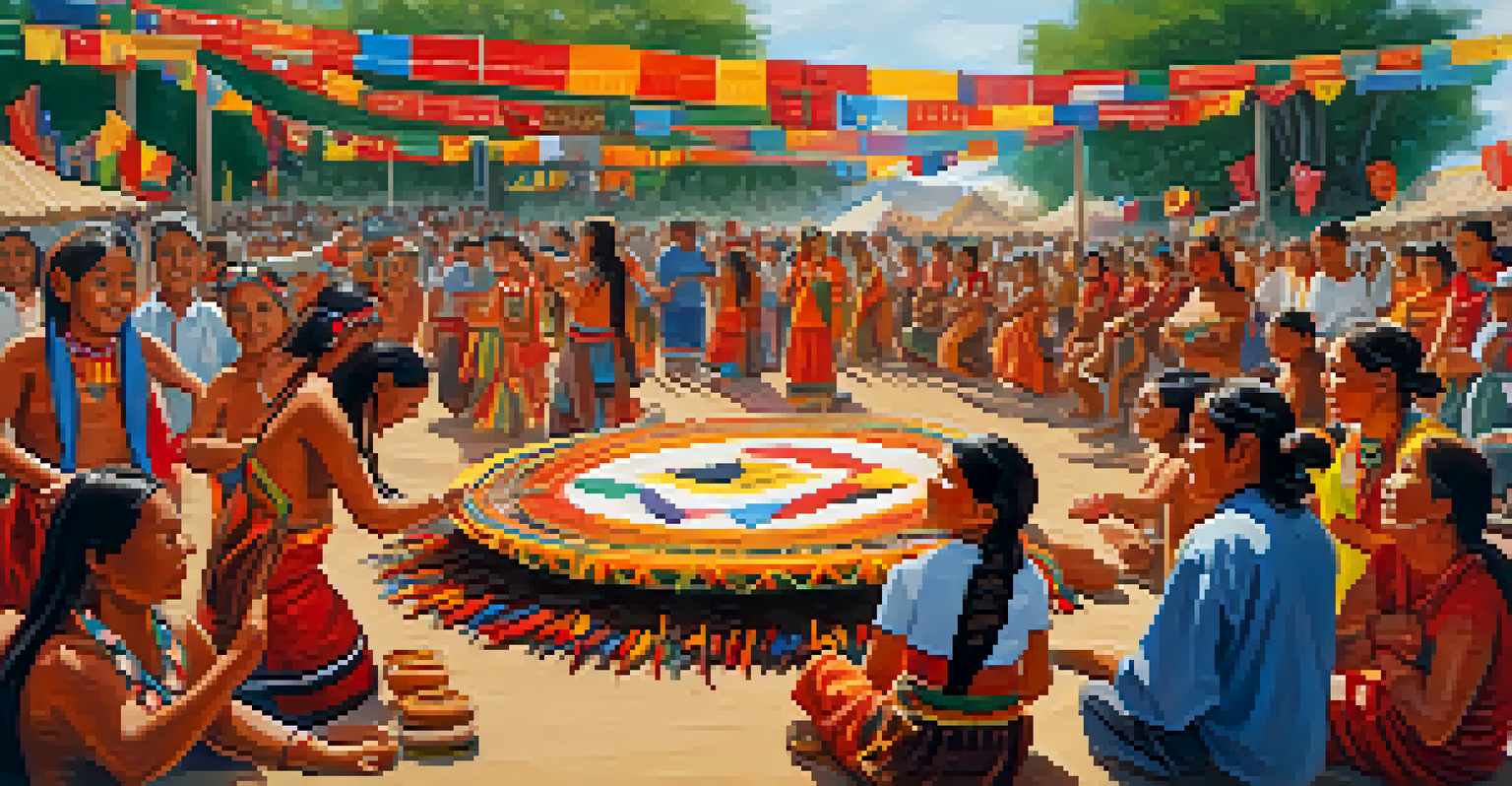Preserving Traditions: Carving in Indigenous Cultures

The Historical Roots of Indigenous Carving Practices
Carving has deep historical roots in many indigenous cultures, serving as a vital form of expression and storytelling. Each piece crafted tells a story, often depicting ancestral tales, spiritual beliefs, or daily life experiences. This practice has been passed down through generations, creating a rich tapestry of cultural heritage.
Art is the most beautiful of all lies.
Traditionally, indigenous carvings were made from materials like wood, bone, and stone, showcasing the resources available in their environment. The choice of material often holds symbolic meaning, connecting the artist to their land and history. This connection is essential, as it reinforces the identity and continuity of the community.
In many cultures, carving is not just an art form but also a rite of passage, where young apprentices learn from elders. This mentorship fosters a sense of belonging and respect for the craft, as well as the stories and traditions it encapsulates. Thus, carving becomes a living tradition, dynamically evolving yet firmly rooted in the past.
The Symbolism Behind Carved Artifacts
Carved artifacts often carry profound symbolism, reflecting the values and beliefs of the indigenous cultures that create them. For instance, totem poles in the Pacific Northwest feature animals and figures that represent clan lineage and protectors. Each carving serves a purpose, whether as a spiritual guide or as a commemorative piece.

Additionally, the motifs and designs used in carvings can convey messages and lessons. For example, spiral patterns may symbolize the journey of life, while animals might represent traits admired by the community. This storytelling aspect connects the viewer to the culture's philosophy and worldview.
Cultural Identity Through Carving
Carving serves as a vital expression of cultural identity, connecting indigenous peoples to their heritage and ancestors.
The symbols within carving can also adapt over time, reflecting contemporary issues and experiences. As indigenous communities face modern challenges, their art often responds with new meanings, demonstrating resilience and adaptability. This evolution is crucial for preserving traditions while also making them relevant to future generations.
The Role of Carving in Cultural Identity
Carving plays a fundamental role in shaping and expressing cultural identity among indigenous peoples. It serves as a reminder of who they are, where they come from, and the stories they carry. Through their art, they reinforce their connections to ancestors and traditions, ensuring these legacies live on.
The artist is not a special kind of person; rather, each person is a special kind of artist.
In many communities, carving is a communal activity that brings people together. It fosters collaboration and a shared sense of purpose, whether in the workshop or during community events showcasing their work. This collective effort strengthens bonds within the community and enhances cultural pride.
Moreover, as indigenous artists gain recognition in broader societies, their carvings help educate others about their culture. This visibility can challenge stereotypes and promote understanding, allowing for a richer dialogue about indigenous identities. Ultimately, carving becomes a bridge between cultures, fostering respect and appreciation.
Challenges Facing Indigenous Carvers Today
Despite its importance, indigenous carving faces numerous challenges in today's world. Globalization and commercialization can dilute the authenticity of traditional practices, as artists may feel pressured to produce marketable pieces rather than genuine expressions of their culture. This shift can undermine the very essence of the art form.
Additionally, environmental concerns affect the availability of natural resources used in carving, such as specific types of wood that may be endangered or restricted. This scarcity can impact the quality and authenticity of the carvings, as artists struggle to find suitable materials that resonate with their cultural practices.
Challenges for Indigenous Artists
Indigenous carvers face challenges from globalization, environmental concerns, and cultural appropriation, threatening the authenticity of their art.
Moreover, there is an ongoing struggle against cultural appropriation, where non-indigenous individuals or companies profit from indigenous designs without permission or context. This exploitation not only disrespects the art form but also threatens the livelihoods of indigenous artists. Protecting these traditions requires vigilance and respect from both indigenous communities and the broader public.
Revitalizing Carving Traditions Through Education
Education plays a pivotal role in revitalizing carving traditions within indigenous communities. By teaching younger generations the skills and significance of carving, communities can ensure that their cultural heritage is preserved. Workshops and mentorship programs foster a sense of pride and responsibility among youth, encouraging them to engage with their heritage.
Incorporating carving into school curriculums and community programs can further enhance awareness and appreciation for this art form. When students learn about the history and techniques of carving, they gain insights into their culture's richness. This educational approach not only benefits indigenous youths but also promotes understanding among non-indigenous peers.
Moreover, partnerships with local art institutions can provide indigenous artists with platforms to showcase their work. Exhibitions and collaborative projects can highlight the depth and diversity of carving traditions, fostering respect and interest in these cultural practices. This exchange of knowledge and creativity ultimately strengthens community ties and cultural pride.
The Influence of Technology on Carving
Technology has begun to play a significant role in the evolution of indigenous carving traditions. While traditional methods remain crucial, newer tools and techniques can enhance the precision and detail of carved pieces. Artists may now use digital design software to plan their work, allowing for more complex designs that still honor traditional values.
Social media platforms provide an avenue for indigenous carvers to showcase their work globally. This visibility can attract interest and appreciation from wider audiences, helping artists connect with potential buyers and supporters. By sharing their stories and processes online, they can engage with a community that values their culture.
Revitalizing Traditions via Education
Education is essential for preserving carving traditions, empowering younger generations to engage with their cultural heritage.
However, as with any technological advancement, it is essential to maintain the authenticity of the craft. Artists must navigate the balance between embracing innovation and preserving traditional methods. By integrating technology thoughtfully, they can enhance their work while still honoring the heritage that defines their art.
Celebrating Indigenous Carving Through Festivals and Exhibitions
Festivals and exhibitions dedicated to indigenous carving provide a platform to celebrate and promote this vital art form. These events often showcase not only the artworks but also the stories behind them, allowing visitors to connect with the culture on a deeper level. They serve as a vibrant celebration of creativity, tradition, and community.
During these gatherings, artists can demonstrate their techniques, offering attendees a glimpse into the labor and love that goes into each piece. This interactive element fosters appreciation and respect, as people witness the skills and dedication involved in the craft. It also creates opportunities for dialogue between artists and the public.

Furthermore, festivals can help raise awareness about the challenges facing indigenous communities and their art. By highlighting these issues, organizers can encourage visitors to support indigenous artists and advocate for their rights. This collective effort to celebrate and protect carving traditions is essential for the ongoing vitality of indigenous cultures.